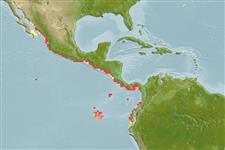Environment: milieu / climate zone / depth range / distribution range
Ecología
marino; agua dulce; salobre; rango de profundidad 0 - 50 m (Ref. 189). Tropical; 28°N - 6°S, 111°W - 77°W (Ref. 189)
Eastern Pacific: central part of the Gulf of California (Rio Yaqui, Mexico) to the Gulf of Guayaquil, Peru.
Tamaño / Peso / Age
Maturity: Lm ? range ? - ? cm
Max length : 8.9 cm TL macho / no sexado; (Ref. 96339)
Espinas dorsales (total): 0; Espinas anales 0; Radios blandos anales: 19 - 23. Body moderately elongate, but somewhat compressed. Snout fairly short, about 3/4 eye diameter; maxilla long, tip sharply pointed, reaching almost to edge of gill cover; gill cover canals of walkeri-type. Anal fin moderate, its origin under or a little before midpoint of dorsal fin base. A narrow silver stripe along flank.
Pelagic (Ref. 96339). A schooling species occurring in coastal waters, most often in muddy estuaries in fully salt, brackish or apparently freshwater, penetrating only a few kilometers up rivers. Maturing females were caught in January, August and October in the Gulf of Nicoya, Costa Rica, suggesting a protracted spawning season. The eggs are oval. TL = 1.219 SL.
Life cycle and mating behavior
Madurez | Reproducción | Puesta | Huevos | Fecundidad | Larva
Spawn in school (Ref. 205).
Whitehead, P.J.P., G.J. Nelson and T. Wongratana, 1988. FAO Species Catalogue. Vol. 7. Clupeoid fishes of the world (Suborder Clupeoidei). An annotated and illustrated catalogue of the herrings, sardines, pilchards, sprats, shads, anchovies and wolf-herrings. FAO Fish. Synop. 125(7/2):305-579. Rome: FAO. (Ref. 189)
IUCN Red List Status (Ref. 130435)
Threat to humans
Harmless
Human uses
Más información
ReferenciasAcuiculturaPerfil de acuiculturaRazasGenéticaElectrophoresesheritabilidadEnfermedadesProcesamientoNutrientsMass conversion
ColaboradoresImágenesStamps, Coins Misc.SonidosCiguateraVelocidadTipo de nataciónSuperficie branquialOtolitosCerebrosVisión
Herramientas
Special reports
Download XML
Fuentes de Internet
Estimates based on models
Preferred temperature (Ref.
123201): 23.6 - 28.5, mean 26.9 °C (based on 44 cells).
Phylogenetic diversity index (Ref.
82804): PD
50 = 0.5000 [Uniqueness, from 0.5 = low to 2.0 = high].
Bayesian length-weight: a=0.00513 (0.00232 - 0.01135), b=3.14 (2.96 - 3.32), in cm total length, based on LWR estimates for this Genus-body shape (Ref.
93245).
Nivel trófico (Ref.
69278): 3.3 ±0.4 se; based on size and trophs of closest relatives
Resiliencia (Ref.
120179): Alto, población duplicada en un tiempo mínimo inferior a 15 meses (Preliminary K or Fecundity.).
Fishing Vulnerability (Ref.
59153): Low vulnerability (10 of 100).
